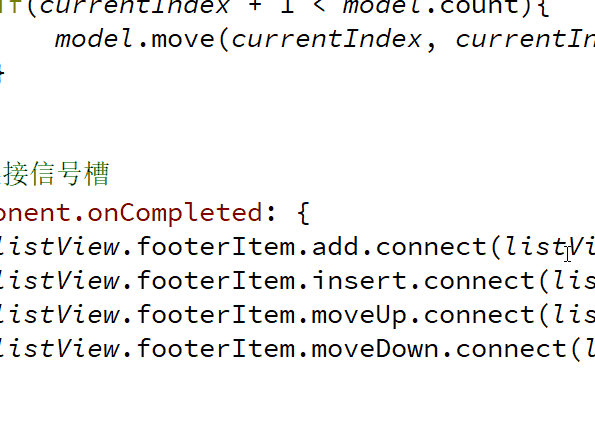ListView 提供了 add、remove、move、populate、displaced 幾種場景的過渡動畫效果,你 可以通過設置相應的屬性來改變特定場景對應的過渡動畫。這些場景對應的屬性,類型都是 Transition,—個場景也可能有多個屬性,比如新增 Item 會觸發 add 過渡動畫,同時也可能引 起其他 Item 的位置變化,進而觸發 addDisplaced 或 displaced 過渡動畫。
效果

初始化 動畫
ListView 第一次初始化使用 populate 動畫:
// 在ListView第一次實例化或者因Model變化而需要創建Item時應用
populate: Transition {
NumberAnimation {
property: "opacity"
from: 0
to: 1.0
duration: 1000
}
}
這將產生一個漸顯效果。
add 動畫
add 屬性指定向 ListView 新增一個 Item 時針對該 Item 應用的過渡動畫。其設置了一個 ParallelAnimation,內含一個變換透明度的動畫和一個變換 y 位置的動畫。
// add過渡動畫(新增Item觸發)
add: Transition {
ParallelAnimation{
NumberAnimation {
property: "opacity"
from: 0
to: 1.0
duration: 1000
}
NumberAnimation {
properties: "x,y"
from: 0
duration: 1000
}
}
}
最終的效果是,新增 Item 從 ListView 上方漸現、緩緩下落到特定位置。 需要注意的是,盡量不要在 add 動畫中改變 Item 的高度,因為這樣會引起它下面的其他 Item 被重新布局進而錯放位置,也會帶來性能上的損耗。
displaced 動畫
我點擊 “Insert” 按鈕時,新增 Item 下方的那些被迫移位的 Item,沒有明顯的動畫效果。 這是因為 displaced 屬性默認為 null,ListView 沒有提供默認的移位動畫。
displaced 屬性用於指定通用的、由於 Model 變化導致 Item 被迫移位時的動畫效果,而相應 的 addDisplaced、moveDisplaced、removeDisplaced 則用於指定由特定的 add、move、remove 操作引起的移位動畫。如果你同時指定了 displaced 和 xxxDisplaced,那 xxxDisplaced生效;如果你只指定 displaced,那只要有移位發生,displaced 動畫就會被應用。
// 用於指定通用的、由於Model變化導致Item被迫移位時的動畫效果
displaced: Transition {
SpringAnimation {
property: "y"
spring: 3
damping: 0.1
epsilon: 0.25
}
}
再運行看看,點擊 “Insert” 按鈕,會發現位於新增 Item 下方的那些 Item 會向下移動,來回彈幾次才平靜下來。
remove 動畫
remove 屬性指定將一個 Item 從 ListView 中移除時應用的過渡動畫。當動畫開始執行時, Item 已經被移除,此時任何對該 Item 的引用都是非法的。移除一個 Item 可能會導致其他 Item 移位,此時會觸發 removeDisplaced 或 displaced 過渡動畫。給 ListView 指定 remove 動畫如下:
// remove過渡動畫(移除Item觸發)
remove: Transition {
SequentialAnimation{
NumberAnimation {
properties: "y"
to: 0
duration: 600
}
NumberAnimation {
property: "opacity"
to: 0
duration: 400
}
}
}
再運行看看,雙擊一個 Item,它會先移動到 ListView 頂部,然后再慢慢變得看不見。
move 動畫
move 屬性指定移動一個 Item 時要應用的過渡動畫。
// move過渡動畫(移動Item觸發)
move: Transition {
NumberAnimation {
property: "y"
duration: 700
easing.type: Easing.InQuart
}
}
上移 + 下移
我們以之前的示例為基礎,構造一個專門演示動畫效果的示例,phone_list_animation. qml。我給 footer 添加了 Up 和 Down 按鈕,還增加了 moveUp 和 moveDown 信號,連接到 ListView 新增的 moveUp() 和 moveDown() 方法上。新的 footer 組件定義如下:
// 定義footer
Component {
id: footerView
Item{
id: footerRootItem
width: parent.width
height: 30
// 自定義信號
signal add()
signal insert()
signal moveUp()
signal moveDown()
// 新增按鈕
Button {
id: addOne
anchors.right: parent.right
anchors.rightMargin: 4
anchors.verticalCenter: parent.verticalCenter
text: "Add"
onClicked: footerRootItem.add()
}
// 插入按鈕
Button {
id: insertOne
anchors.right: addOne.left
anchors.rightMargin: 4
anchors.verticalCenter: parent.verticalCenter
text: "Insert"
onClicked: footerRootItem.insert()
}
// 下移按鈕
Button {
id: moveDown;
anchors.right: insertOne.left
anchors.rightMargin: 4
anchors.verticalCenter: parent.verticalCenter
text: "Down"
onClicked: footerRootItem.moveDown()
}
// 上移按鈕
Button {
id: moveUp;
anchors.right: moveDown.left
anchors.rightMargin: 4
anchors.verticalCenter: parent.verticalCenter
text: "Up"
onClicked: footerRootItem.moveUp()
}
}
}
ListView 新增 moveUp() 和 moveDown() 方法,計算當前 Item 的索引,調用 model 的 move() 方法讓當前 Item 下移一個位置。給 move 屬性設置了一個 Transition 對象。新的 ListView 聲明如下:
// 定義ListView
ListView {
id: listView
anchors.fill: parent
interactive: false
delegate: phoneDelegate
model: phoneModel.createObject(listView)
header: headerView
footer: footerView
focus: true
highlight: Rectangle{
color: "lightblue"
}
// 在ListView第一次實例化或者因Model變化而需要創建Item時應用
populate: Transition {
NumberAnimation {
property: "opacity"
from: 0
to: 1.0
duration: 1000
}
}
// add過渡動畫(新增Item觸發)
add: Transition {
ParallelAnimation{
NumberAnimation {
property: "opacity"
from: 0
to: 1.0
duration: 1000
}
NumberAnimation {
properties: "x,y"
from: 0
duration: 1000
}
}
}
// 用於指定通用的、由於Model變化導致Item被迫移位時的動畫效果
displaced: Transition {
SpringAnimation {
property: "y"
spring: 3
damping: 0.1
epsilon: 0.25
}
}
// remove過渡動畫(移除Item觸發)
remove: Transition {
SequentialAnimation{
NumberAnimation {
properties: "y"
to: 0
duration: 600
}
NumberAnimation {
property: "opacity"
to: 0
duration: 400
}
}
}
// move過渡動畫(移動Item觸發)
move: Transition {
NumberAnimation {
property: "y"
duration: 700
easing.type: Easing.InQuart
}
}
// 新增函數
function addOne() {
model.append(
{
"name": "MX3",
"cost": "1799",
"manufacturer": "MeiZu"
}
)
}
// 插入函數
function insertOne() {
model.insert( Math.round(Math.random() * model.count),
{
"name": "HTC One E8",
"cost": "2999",
"manufacturer": "HTC"
}
)
}
// 上移函數
function moveUp() {
if(currentIndex - 1 >= 0){
model.move(currentIndex, currentIndex - 1, 1)
}
}
// 下移函數
function moveDown() {
if(currentIndex + 1 < model.count){
model.move(currentIndex, currentIndex + 1, 1)
}
}
// 連接信號槽
Component.onCompleted: {
listView.footerItem.add.connect(listView.addOne)
listView.footerItem.insert.connect(listView.insertOne)
listView.footerItem.moveUp.connect(listView.moveUp)
listView.footerItem.moveDown.connect(listView.moveDown)
}
}
}
現在可以執行 “qmlscenephone_list_animation.qml” 看看效果了。
下載鏈接
全部代碼下載鏈接:https://github.com/confidentFeng/QML_Demo/tree/master/ListViewPhone
參考:
《Qt Quick核心編程》第13章
